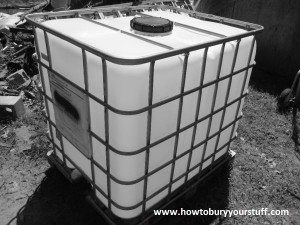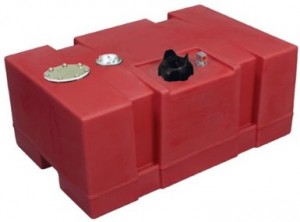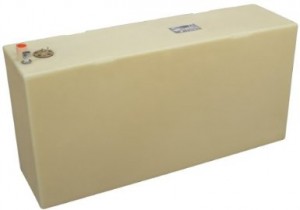Underground Fuel Storage
Because no one can take what they cannot find
Do you consider it paranoid to bury fuel? Unleaded gasoline and diesel theft are already quite common in every small town and every big city in the world. It’s not quite as common as retail theft but as the oil prices worldwide slowly rise, so does fuel theft. What do you think would happen to fuel theft statistics and crimes involving petroleum products in the event of an economic crash, natural disaster or any other event that could disrupt the oil industry? A single gallon of lamp oil or kerosene could fetch a hefty price many times it’s current value.
Want a tip for the long term storage of fuel? Gasoline is a perishable product and most preppers will agree that it’s preferable to use generators, lanterns and heaters that run from kerosene, diesel, lamp oil or even peanut oil because they degrade much more slowly. If you insist on stockpiling gasoline, it’s critical that you rotate it out with fresh product and caching underground may not be feasible. When storing liquid fuels, gasoline in particular, it’s important to completely fill your fuel jugs and tanks all the way up in order to remove as much air as possible. Here’s why…
Take an empty 20 ounce Coca-Cola bottle, rinse and dry it out completely. Screw the lid on tight and alternate placing the empty bottle in the freezer, then outside on a hot summer day and back in the freezer again. Sooner or later, if you continue to do this, moisture will start appearing on the inside of the bottle. This is the exact same thing that can happen to all of your fuel cans and gas tanks.
Have you ever tried starting a car that has just been parked in a garage or a field for a year or more? Even if there’s nothing wrong with the engine, it will more than likely smoke a little and won’t run very smoothly at first. This is due (in part) to the water that has condensed on the inside of the vehicle’s fuel tank. The daily rise and fall of the outside air temperature in response to the repeated transition from day to night slowly causes moisture to form and mix with the gas. A completely full tank of gas will last longer.
It’s as critical to provide temperature insulation for your liquid fuels as it is your electronic circuit boards, ammunition cartridges, medication bottles, documents and firearms. If you are uncomfortable storing flammable liquids in your home or other temperature controlled building, then one might consider burying them. Caching fuel underground; especially below the frost line, will help protect it from both moisture condensation and thieves or looters should any “chaotic” events occur.
 If you are serious about burying fuel, then you’ll need to be serious about the container you’re placing it in. The above photograph shows a common and easy-to-find 264 gallon fuel tote. They are commonly found on farms or around factories and a used or discarded one will be affordable for almost anyone. You’ll need to clean it out thoroughly and check it for leaks or damage just as thoroughly. These totes are perfect for storing diesel or kerosene and the only disadvantages to them are that sunlight degrades the plastic (if you leave it outside, cover it) and you may need to consider something bigger than a shovel if you intend to bury one of them.
If you are serious about burying fuel, then you’ll need to be serious about the container you’re placing it in. The above photograph shows a common and easy-to-find 264 gallon fuel tote. They are commonly found on farms or around factories and a used or discarded one will be affordable for almost anyone. You’ll need to clean it out thoroughly and check it for leaks or damage just as thoroughly. These totes are perfect for storing diesel or kerosene and the only disadvantages to them are that sunlight degrades the plastic (if you leave it outside, cover it) and you may need to consider something bigger than a shovel if you intend to bury one of them.
Fifty-five gallon drums are also an option but if you are burying them they NEED to be plastic or galvanized steel to ensure against rust. They are easier to handle and probably easier to find. As with the 264 gallon totes, all one would require is a small hand-operated pump and you’re in business. if you are burying a galvanized steel drum, check for scratches or gouging in the paint and repair if necessary, as this is where rust would begin. Another option would be marine grade fuel tanks such as this Moeller 25 gallon tank.
>> Click here to get current pricing and reviews from Amazon.com on Moeller 25 Gallon Tank <<
…or this Moeller 50 gallon model. Moeller has an excellent reputation for quality and one can find strong recommendations from any number of sources.
>> Click here to get current pricing and reviews from Amazon.com on Moeller 50 Gallon Tank <<
I felt that I should mention that none of this is a consideration with pressurized LP gas, or propane as it’s more commonly known. Propane is just that, propane. Whether you buy a small canister of propane for a lantern or a large tank for your home’s central heating system there is nothing else inside the can or tank. There is no air and thus no moisture. You can go to your local Wal-Mart, purchase a dozen cans of Coleman brand propane, stick them in the corner of your garage, leave them for 30 years and the propane will burn just the same as it would have on the very day that you bought it. Bear in mind though that propane tanks will rust and that if you cache them underground, you must take every precaution to ensure that they stay dry.
Last but certainly not least, I also felt as though I should mention the possible legalities involving the underground burial of hazardous materials. Every individual is responsible for checking with his/her local, state, provincial and federal authorities regarding the regulations concerning the underground caching of petroleum-based liquid fuels and compliance with these laws is paramount. Even if this is legal in your location, and even if you are properly licensed to store fuel either above ground or underground; any leakage of petroleum products is your responsibility. No matter what country or part of the world you live in; this will probably include clean-up costs, civil penalties including fines and criminal charges involving negligence.
Obeying any relevant laws or regulations ensures both the safety of the environment and the safety of your precious fuels. Filling any type of fuel container these days is never cheap so you’ll want to be downright meticulous is choosing and placing a container.
Comments are currently closed.
 How to Bury Your Stuff
How to Bury Your Stuff

